New data show that sea salt is not a viable strategy for reducing sodium levels
-
Last Update: 2021-02-04
-
Source: Internet
-
Author: User
Search more information of high quality chemicals, good prices and reliable suppliers, visit
www.echemi.com
as a means of reducing sodium in food is not feasible, because sea salts as coarse salts have the same amount of sodium.The latest study, published in the International Journal of Food Research, lists the characteristics of seven types of sea salt and provides clean food control. The results
salts contain "the same or less sodium than coarse salts."The study showed that small differences in sodium levels in the sample could be detected, and when sodium levels were controlled, they would lead to significant differences in salty strength.“ This suggests that using any sea salt is not a viable strategy for reducing sodium content. The
isthat many shoppers are still misconsuming that sea salt contains less sodium than salt. The American Heart Association's findings show that 61% of U.S. consumers believe that sea salt can replace salt (mined in the bottom salt mine, treated with eliminated minerals, including compound fertilizer anti-blocking agents) as a low-sodium salt salin is of course an important nutrient that is necessary for human function. However, the average daily salt consumption in Western countries is 10-12 grams, well above the recommended level of 5 grams per day recommended by the World Health Organization/FAO to control blood pressure levels in the population and reduce the prevalence of hypertension and associated health risks.Consumers believe that sea salt is at least better than salt based on the fact that sea salt contains additional minerals such as magnesium, potassium, calcium, bromine, and heavy carbonate.Although it has been shown that sea salt and salt have the same amount of sodium, researchers at the University of Guelph point out that "a small amount of salt crystal properties have been shown in the literature to contribute to the taste of salt".According to the new data, the three sea salt test samples had the same sodium content as coarse salts, while the real lid surface (Hawaii, U.S.) region had 16.75 percent less sodium than coarse salts., however, the researchers say there is little difference in maximum salty intensity.
concluded: "Based on the fact that sea salts do not vary much in flavor strength, and that there is no less sodium than coarse salts." Therefore, it is not feasible to use the sea salt studied as a strategy with less sodium salt. ”
This article is an English version of an article which is originally in the Chinese language on echemi.com and is provided for information purposes only.
This website makes no representation or warranty of any kind, either expressed or implied, as to the accuracy, completeness ownership or reliability of
the article or any translations thereof. If you have any concerns or complaints relating to the article, please send an email, providing a detailed
description of the concern or complaint, to
service@echemi.com. A staff member will contact you within 5 working days. Once verified, infringing content
will be removed immediately.







